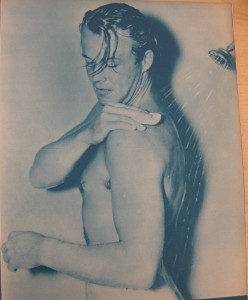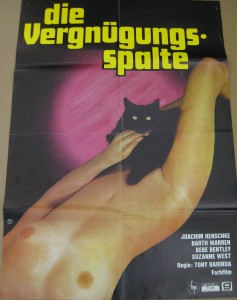Erotica
June 14th, 2010
Erotica, sexploitation, pornography all find their way into the film archives and the HFA’s collection is no exception. Not everyone talks about these often secret collections, a censoring silence which can stymie researchers.
Almost any collection of film contains something a bit naughty. Pornographic films were, after all, invented almost as soon as motion picture film was invented.
While processing a recent collection procured by the Harvard Film Archive, I kept wondering where the dirty little secrets were. Finally I found them: some 16mm 1920s nudie films, possibly the least offensive items I could have imagined, many of which have opening titles which read: “A producer’s note: this picture is solely for the development of graphic arts, an aid to sculptors, artists & designers who may not have a living model.”
The majority of the HFA’s erotic films are from the Grove Press Collection, but there are a few others that turn up here and there, and include everything from silent nudies to stag films to softcore and hardcore pornography. Many of the pornographic films from the Grove Press Collection have been shown in the HFA’s Cinematheque.
Most recently I have noted some ephemeral material that is best categorized as Sexploitation in the Lothar and Eva Just Film StillsCollection (shown below).
Home Movie Day
October 13th, 2009
The 7th annual Home Movie Day will be held at the HFA on Saturday October 17th.
Over the years we have seen a wide variety of films at Home Movie Day, from an amateur Tarzan re-enactment by kids in the 1930s to film taken on an oceanliner in the 1920s. Last year a teenage spy film hit the screen to great acclaim. Classic home movies of barbecues and family vacations are our bread and butter, and they never cease to surprise and delight the crowd.
Why home movies? Because these little films, yours, or your grandma’s, or the ones you found at the junkyard, are unique and personal, potentially interesting, funny, pretty, fascinating and strange, and certainly worth a watch. Be the star of the show!
We provide the screen, projectors, projectionists, film inspectors, music, and information about film preservation and home movies in general, you provide the films.
The films you bring can be new or old (but don’t bring films we’ve shown at Home Movie Days past), they can belong to you or someone else. They should be amateur (not mass-produced), but those are the only guidelines.
Free Event
Saturday October 17 at 1pm

Home Movie Day
Check in with your films at 11am
Films will screen 1-4pm
In room B-04 in the lower level of the Carpenter Center
24 Quincy Street, Cambridge
Bring out your home movies on super 8, 8mm, 16mm, VHS, DVD, or other video format (bring a player or camera). Video is limited to 5 minutes. Local film archivists will be on hand to discuss home movie preservation.
Each film must be inspected for damage before being run on a projector, so please drop off your film as early as you can. If possible, drop off your film at the HFA office the week prior to the event.
For more information about Home Movie Day and locations around the country, visit the Home Movie Day website, homemovieday.org.
Update: One More Unidentified Film Still
September 23rd, 2009
Thanks to film archivists around the country, all the stills in the previous post were positively identified within hours of posting them.
Nice work everyone!
Anyone well-versed in the world of Abbott and Costello is welcome to identify the still below.
email me with your answer
coffey (at) fas (dot) harvard (dot) edu

the sign in the window reads Shirts & Neckties. The number is 616-3, but it doesn't appear to match a Universal picture.
Film box cover art
September 14th, 2009
The HFA has a new display case in our office at the Carpenter Center. This month’s exhibit is from my present favorite, the Howard E. Burr Collection.
These boxes once housed films sold to the home market, and they fall into a few categories.
First, the newsfilm, newsreel, sports, or other newsy documentary film. These are generally serial or magazine -type films. The covers don’t have much variation from month to month.
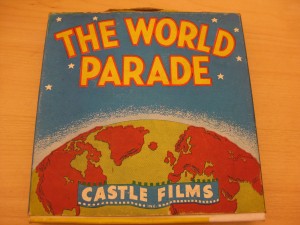
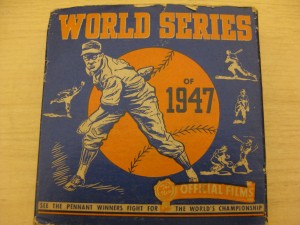
Next up, the cartoon. Most of these cartoons are not one-offs, so the same cover could be used for all Happy Hooligan cartoons, for instance, with only the name (printed on the side) changing for each box.

Soundies are another example of a somewhat generic cover that could be used again and again, the only variation being the color of the box and the description of the content. Soundies were short musical films, a pre-cursor to the music video.
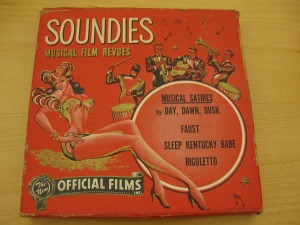
Several distributors, finding their content appealing and their name well recognized, chose to sell their films in a generic box almost all the time.

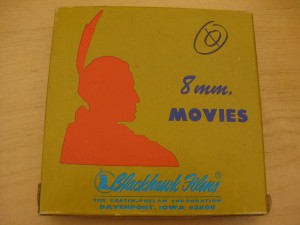
Of course, a generic box was also a cost cutter, as was re-using an image.

Many times, reduction prints of feature films had exciting covers showing scenes from the film.



To see these covers and more in person, drop by our office.
sound on disc
September 7th, 2009
In the young days of cinema, one of the first methods for presenting a film with recorded sound was to employ a method of sound on disc. In the mid-1920s, films were occasionally distributed with an accompanying record. The projector for this type of presentation had a record player attached to the base, and the record and film would be synched up by the projectionist. As one might imagine, the synch didn’t always work, sometimes the record would skip or perhaps the operator would put on the wrong record. It wasn’t a perfect system.
In the later 1920s, sound on film, which was a system that had been simmering for a few years, broke through and changed popular cinema forever, effectively killing the silent feature film. This technique of sound on film, still in use today, provides an optical soundtrack on the edge of the film, which means it never goes out of synch (unless there has been a mix-up in the production of the track) as well as avoiding other problems of sound on disc.
Sound on disc made a brief re-appearance in the 1990s with the introduction of the digital sound on CD format, DTS. In this format, the 35mm print was released with an optical soundtrack as well as digital track on CD. To use this system, there would be a time code reader on the projector that read an optical timecode on the film (see below), which kept the CD track in synch with the picture. As with other theatrical digital formats, the analogue optical soundtrack is retained, and in case of failure of the digital sound, the projector can revert to the optical soundtrack.
This image, below, from Kill Bill (Tarentino, 2003), shows the 4 modern soundtracks. The left side of the film shows two digital tracks, Sony’s blue SDDS on the outer edge of the perforations, Dolby’s black digital information between the perforations, and to the right of the perforations, the two white lines of analogue optical soundtrack (variable area), and the DTS optical timecode (white vertical dashes to the immediate left of the image), which is used to keep the CD in synch with the picture.

I discovered today, while working with the Burr Collection, that sound on disc found its way to the home movie market as late as 1966. The 8mm film pictured below, perhaps not surprisingly, is a compilation film from the 1920s/1930s when cinema’s comedians were coming out of a career in vaudeville.
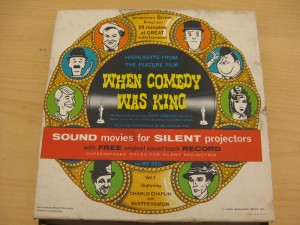
8mm sound on disc
The record provided with this film could be played on standard record player, but it is a flexi-disc, the cheapest of disc recordings. This type of record could also be found in magazines as an advertisement or free song.
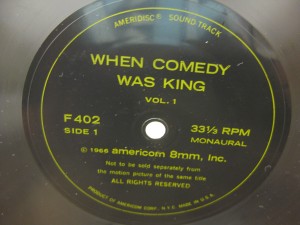


NHF Summer Symposium
August 31st, 2009
Last month the HFA’s Conservation Center staff attended the annual Summer Symposium at Northeast Historic Film in Bucksport, ME. The theme of this year’s symposium was Ways of Watching.
Papers were delivered on topics as diverse as watching and interpreting the home movies of strangers, presenting films at a department store in the early days of cinema, and viewing films in classrooms.
This was a great opportunity for the HFA to present some films from the Howard E. Burr Collection. We realized that, although the scholars and archivists at the symposium were very interested in watching films, some may not have ever seen a film projected, as many researchers access film through digital or video copies of the actual film. Most had probably not watched films at the home of a collector, and many had probably not seen the films I chose to project for them.
We decided to set up a screening night that would roughly represent a typical screening night in the home of a film collector. We didn’t want the screening to take place at the same venue as the symposium, which was held in NHF’s movie theatre, because the nature of the event demanded a more intimate atmosphere. A local participant in the symposium generously volunteered to host the screening at her home, which was perfect.
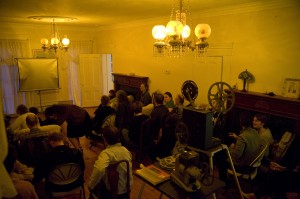
Not all collectors present their screenings in the same way, but there tends to be a common wish to “put on a show,” frequently aping the habits of the cinema during Hollywood’s Golden Age. Rare is the screening of only one title. “Doc” Burr’s daughter described screening nights at his home, which represent the habits of many others: “He was big on showing newsreels, a travelogue, previews of coming attractions, or cartoons (sometimes one of each!) preceding the feature.” For the NHF screening night we attempted a similar program (although far shorter).
We presented film on 3 small gauge formats common to the US home cinema market: 16mm, 8mm, and super 8. First, an 8mm reduction print of a silent Mack Sennett comedy, The Campus Carmen (1928). Next up, New England Holiday!, a 16mm short, silent travelogue from the 1940s about vacationing in New England. In keeping with tradition, we moved to a cartoon, Farmer Gray in English Channel Swim (1925), shown in 16mm. The “feature” finale was a super 8 condensed reduction print of Taxi Driver (1976), with mag sound.
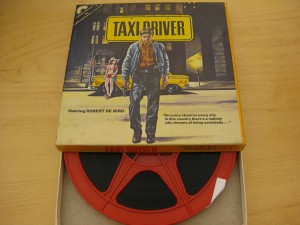 It was not unusual for studios to release condensed versions of features for the home market. Most common are the 8mm or super 8 silent versions that take a feature film and reduce it to its best 5 minutes, using inter-titles to explain the story.
It was not unusual for studios to release condensed versions of features for the home market. Most common are the 8mm or super 8 silent versions that take a feature film and reduce it to its best 5 minutes, using inter-titles to explain the story.
This version of Taxi Driver was a little different. The tale was cut down to the story of Travis, the pimp, and Iris (the teenage prostitute). A narrator is employed to describe some gaps in the story. “Travis Bickle has decided to take revenge against the pimp.” The original sound from the film is retained. “You lookin’ at me?” Using only the scenes of sex and violence, the film is reduced to an exploitation version of itself.
The screening was a perfect coda to the symposium. Everyone welcomed the opportunity to sit and watch films projected from a few feet behind them, the unfamiliar noise of the projector becoming part of the show. People who were not familiar with these “home versions” of feature films were fascinated by them. The woman who had not seen Taxi Driver had her fears confirmed, but has lived to tell the tale.
Upon returning home, we discovered quite a number of these super 8 sound condensed films, and hope to put a screening together for the public. Keep an eye on our calender for details.

Welcome to the HFA Collections Blog
February 10th, 2009

Welcome to our blog. We’ll be writing about the Harvard Film Archive’s Collection, which has over 15,000 items, mostly 16mm and 35mm film.
The image above is a frame enlargement from the film Child of the Big City, by Yevgenii Bauer.
